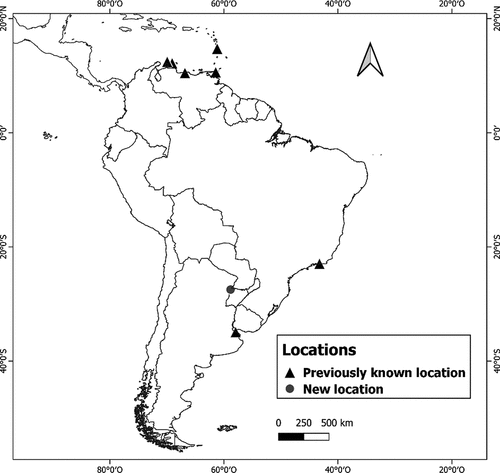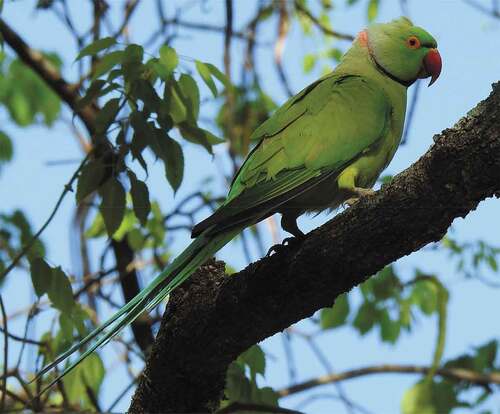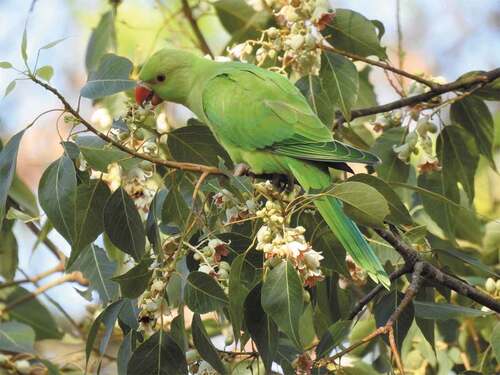ABSTRACT
The Rose-ringed parakeet (Psittacula krameri), native to India, South Asia, and Sub-Saharan Africa, is considered one of the most invasive bird species. It has been recorded in 37 countries, in some of which it was originally introduced as a pet. It has become an agricultural pest and a threat to native birds in many countries. In South America, populations of this species were only known to exist in Venezuela and the Caribbean Islands. We report the finding of a small reproductive population of Rose-ringed parakeets in the city of Corrientes, in northeastern Argentina. We provide information on its observed feeding patterns and interactions with two other species of birds. We suggest monitoring the species and its population trends, as well as starting an awareness campaign of the dangers to native fauna posed by invasive alien species.
The concept of invasive alien species refers to all those species introduced by humans that have dispersed and established themselves outside their natural range, posing a threat to biodiversity [Citation1,Citation2]. These species are frequently opportunistic and easily adaptable to new environments, which allows them to rapidly increase their populations [Citation1]. They are also the main cause of extinction, retraction and restructuration of biological populations [Citation1,Citation3]. The environmental damage produced by invasive species is associated with significant economic costs and an increased risk to human health [Citation4,Citation5].
Among the vertebrate species that have been introduced by humans to areas beyond their native ranges, birds are the most common, with more than 1400 attempts to introduce 400 bird species worldwide [Citation6]. Of these species, parrots are one of the most popular groups due to their colorful plumage, size, and longevity, among other characteristics, which make them highly prized by collectors [Citation7,Citation8]. Due to their wide ecological tolerance and synanthropic behavior, parrots have a high capacity to give rise to new populations from a small number of introduced individuals [Citation8].
The Rose-ringed parakeet (Psittacula krameri) is the most widely introduced parrot in the world and is considered one of the most invasive bird species [Citation9–11]. From its original geographic range (India, South Asia, and Sub-Saharan Africa), it has expanded to 37 countries on all continents [Citation12] through traditional bird trafficking routes [Citation11]. This process has been favored by its high tolerance to a wide range of climatic conditions [Citation13], and its adaptability to a variety of wooded habitats such as farms, gardens and urban parks, as well as forests close to cities [Citation14]. In many countries, it is a major agricultural pest and a competitor of native wildlife [Citation15–18].
The only places in South America with populations of Rose-ringed Parakeet are Caracas (Venezuela), the Islands of Aruba, Curaçao and Trinidad and Tobago [Citation12,Citation19]. There is also a record of a specimen collected, without further information, in Rio de Janeiro, Brazil, and deposited in the Royal Ontario Museum [Citation20]. In Argentina, there is only one record of a single individual observed in 2008 in the city of La Plata (Province of Buenos Aires). It probably escaped or was released from captivity [Citation21]. No previous reports exist of established populations in the country. For this reason, we consider it important to report the existence of a small population of P. krameri in the city of Corrientes, in the northeast of Argentina.
The city of Corrientes (27° 29′ 0″ S, 58° 49′ 0″ W, 52 masl) is the capital of the homonymous province located in northeastern Argentina (). It has an area of 90 km2 and a population of 346,000 inhabitants [Citation22]. The climate is subtropical: eight months with an average temperature above 20°C, and the remaining months with an average temperature of 10–20°C. Annual rainfall reaches 1300 mm, with the highest concentrations in the summer months (December to March) [Citation23].
Figure 1. Previously and new locations with Rose-ringed Parakeet (Psittacula krameri) in South America.

On 16 October 2020 a note was published in a local media outlet mentioning the presence and nesting of this species in an unspecified park in the city. Two days later, we sighted a male Rose-ringed Parakeet in one of the city’s parks. It was perched low and took off before being photographed. On the 24th of that month, we returned to the place early in the morning and were able to see a group made up of a male () and two adult females; they were accompanied by two juveniles that had evidently left the nest barely a few days before. The nest was identified as the same one that appeared in the photograph that accompanied the journalistic note. It was located in an unexcavated hole in the decaying heartwood of a still-living branch of an old specimen of Peltophorum dubium (Fabaceae). The tree had a height of approximately 15 m and 103 cm in diameter at breast height. The branch, 85 cm in diameter, was located 4.5 m from the ground and inserted into the trunk at an angle of 50° to the horizontal, and an orientation of 120° to the north. It was 100% covered by foliage. We were unable to access the nest to examine it in more detail.
Figure 2. Rose-ringed parakeet (Psittacula krameri) male, in the city of Corrientes, Argentina, in October 2020.

During that and the following day, we observed the behavior of the group between 7 am and 9 am. During that time, the parrots stayed within the park and its surroundings, not moving away more than 100 m. The parrots were observed feeding on dry seeds of Handroanthus heptaphyllus (Bignoniaceae), on the seeds of the still immature samaras of Peltophorum dubium (Fabaceae) and on the flowers of Brachychiton sp. (Malvaceae) (). The juveniles were observed being fed, on several occasions, by both the male and the females, who regurgitated a whitish and pasty substance. However, we also saw the juveniles pluck and consume pieces of epiphytic lichens (Parmeliaceae). Adults were also seen descending to the ground, together with Rock Pigeons (Columba livia), to consume bird food thrown by park visitors.
Two interactions of juvenile parrots with two species of native birds were recorded. On one occasion, one of the juveniles harassed and displaced an Eared Dove (Zenaida auriculata) from the branch where it was perched. Minutes later, another juvenile was attacked and dislodged from its perch by a Creamy-bellied Thrush (Turdus amaurochalinus).
On 28 February 2021 shortly after sunrise, another group of four individuals was observed on a pedestrian walkway along the Paraná River, about 1000 m in a straight line from the park where the first group was observed. Unlike those, these individuals were very suspicious of humans and did not allow us to approach to less than 50 m. They moved away after a while, before we were able to photograph them or reliably identify their sex.
This is the first documented record of the presence of a small reproductive population of Rose-ringed Parakeets in Argentina, which to date would be the southernmost in the Americas. Residents close to the park said they saw the Rose-ringed Parakeets for the first time one year ago, but they do not know their origin nor their exact number. However, these residents affirm that this was the first time the parrots bred in the park (personal communication of N. Duarte to the authors, without references).
Rose-ringed Parakeets are a species with high reproductive and ecological success [Citation24]. They are currently expanding their geographic range, both in their native areas and in many other areas where they have been voluntarily introduced or escaped from captivity [Citation7,Citation11,Citation12,Citation25]. Although the cold climate does not in itself constitute an obstacle for the establishment of this species [Citation13], it can cause phenological imbalances by making the parakeets unable to distinguish between the unfavorable time of the year and the breeding period, reducing their reproductive success and, therefore, their invasive potential [Citation26]. This limitation does not exist in the city of Corrientes, since the northeast of Argentina has a subtropical climate.
In the countries where they have been introduced, interactions between Rose-ringed Parakeets and other bird species are generally negative. These interactions include competition by interference [Citation16,Citation27–29], harassment and intimidation. The species with which they have been known to interact include birds of prey and other large birds such as Common Kestrels (Falco tinnunculus), Little Owls (Athene noctua), Gray Herons (Ardea cinerea) and seagulls [Citation30–32]. Rose-ringed Parakeets have also been known to attack and kill other birds for no apparent reason, such as House Sparrows (Passer domesticus) and Eurasian Blue Tits (Cyanistes caeruleus) [Citation33]. Fatal attacks have also been observed on Red squirrels (Sciurus vulgaris) and Norway rats (Rattus rattus), although these fatal encounters occurred probably due to the fact that these mammals are potential predators of eggs and chicks [Citation28,Citation30]. Although we observed only two direct interactions with other birds, an Eared Dove attacked by a juvenile parakeet, and a parakeet attacked by a Creamy-bellied Thrush, the fact that both parts were aggressive suggests that interspecific interactions are also negative here.
Rose-ringed Parakeets use tree trunk hollows for nesting, which causes conflicts with other species that also use these sites for nesting or refuge [Citation28]. In the city of Corrientes, Rose-ringed Parakeets could enter into competition with native bird species that also nest in tree trunk cavities in city parks, such as Blue-winged Parrotlet (Forpus xanthopterygius), Green-barred Woodpecker (Colaptes melanochloros), and Little Woodpecker (Dryobates passerinus). This is not a minor problem, as it has been confirmed that the Rose-ringed Parakeet can aggressively dislodge and even kill tree cavity occupants. This has been the case with the Greater noctule (Nyctalus lasiopterus), the largest European bat, which has been classified as Vulnerable by the IUCN [Citation34]. Colonies of this bat in the city of Seville (Spain) have been negatively affected by these Rose-ringed Parakeets [Citation27,Citation35].
People generally ignore the risks that invasive alien species pose for the biodiversity of native species. In many cities throughout the world, the presence of exotic parrots is tolerated and welcomed, since many people enjoy the sight of these birds in parks and gardens [Citation36]. Lethal control of invasive species, especially if they are charismatic, is often unpopular and can result in public protests, which hinder and end up canceling these programs [Citation32,Citation37]. In fact, during the course of this work, some park neighbors expressed mistrust and even some hostility towards our presence, believing that we were worked for a government agency in charge of wildlife management. Therefore, these agencies should consider engaging in public education campaigns on the risks that invasive alien species pose to native fauna to discourage people from providing food to feral individuals or releasing them from captivity. A population of Rose-ringed Parakeets introduced to the Island of La Palma (Canary Islands, Spain) was successfully eradicated by involving the local community, without any conflict [Citation38]. In the city of Corrientes, monitoring measures should be adopted to keep track of the status and population trends of this species as part of an adaptive management program.
Author’s contributions
ML Chatellenaz and JM Fernández did the field work and wrote the manuscript together with ML Thomann. ML Chatellenaz took the photographs and JM Fernández elaborated the map.
Acknowledgments
To Victor Zaracho, for sending us the newspaper note that mentioned the reproduction of Rose-ringed Parakeets in the city of Corrientes. To Nicolás Duarte for sharing his observations.
Disclosure statement
No potential conflict of interest was reported by the author(s).
References
- Simberloff D. Invasive species. What everyone needs to know. New York: Oxford University Press; 2013.
- Convention on Biological Diversity. COP 6 Decision VI/23. Alien species that threaten ecosystems, habitats or species Version. 2020 Oct 21. Available from: https://www.cbd.int/decision/cop/?id=7197
- Sax DF, Stachowicz JJ, Gains SD. Species Invasions: insights into Ecology, Evolution and Biogeography. Sunderland Massachusetts: Sinauer; 2005.
- Mack RN, Simberloff DW, Lonsdale M, et al. Biotic invasions: causes, epidemiology, global consequences, and control. Ecol Appl. 2000;10(3):71–689.
- Mooney HA, Cleland EE. The evolutionary impact of invasive species. Proc Natl Acad Sci USA. 2001;98(10):5446–5451.
- Duncan RP, Blackburn TM, Sol D. The ecology of bird introductions. Annu Rev Ecol Evol Syst. 2003;34(1):71–98.
- Juniper T, Parr M. Parrots: a guide to parrots of the world. London: Christopher Helm; 1998.
- Cassey P, Blackburn TM, Russel GJ, et al. Influences on the transport and establishment of exotic bird species: an analysis of the parrots (Psittaciformes) of the world. Glob Chang Biol. 2004;10(4):417–426.
- Butler CJ. Population biology of the introduced ring-necked parakeet Psittacula krameri in UK. Oxford: University of Oxford Dissertation, Edward Gray Institute of Ornithology, Department of Zoology; 2003.
- Mori E, Ancillotto L, Menchetti M, et al. Italian red squirrels and introduced parakeets: victims or perpetrators? Hystrix. 2013;24:195–196.
- Jackson H, Strubbe D, Tollington S, et al. Ancestral origins and invasion pathways in a globally invasive bird correlate with climate and influences from bird trade. Mol Ecol. 2015;24(16):4269–4285.
- BirdLife International. Psittacula krameri. The IUCN Red List of Threatened Species. 2021 Apr 20. Available from: http://www.birdlife.org
- Thabethe V, Thompson LJ, Hart LA, et al. Seasonal effects on the thermoregulation of invasive rose-ringed parakeets (Psittacula krameri). J Therm Biol. 2013;38(8):553–559.
- Strubbe D, Matthysen E. Invasive ring-necked parakeets Psittacula krameri in Belgium: habitat selection and impact on native birds. Ecography. 2007;30(4):578–588.
- Lever C. Rose-ringed parakeet (ring-necked parakeet) Psittacula krameri. In: Lever C, editor. Naturalized birds of the world. London: T. & A.D. Poyser; 2005. p. 124–130.
- Peck HL, Pringle HE, Marshall HH, et al. Experimental evidence of impacts of an invasive parakeet on foraging behavior of native birds. Behav Ecol. 2014;25(3):582–590.
- Vall-llosera M, Woolnough AP, Anderson D, et al. Improved surveillance for early detection of a potential invasive species: the alien Rose-ringed parakeet Psittacula krameri in Australia. Biol Invasions. 2017;19(4):1273–1284.
- Shivambu TC, Shivambu N, and Downs CT. Aspects of the feeding ecology of introduced Rose ringed Parakeets Psittacula krameri in the urban landscape mosaic of Durban, KwaZulu Natal Province, South Africa. J Ornithol. 2021; 162(2): 397–407.
- Global Biodiversity Information Facility. Version. 2021 Apr 20. Available from: https://www.gbif.org/es/species/2479226
- Millen B. Ornithology Collection Non Passeriformes - Royal Ontario Museum. Version 16.13. Royal Ontario Museum. Version. 2021 Apr 20. Available from: https://www.gbif.org/occurrence/1211917622
- eBird Argentina. Version. 2021 Apr 20. Available from: https://ebird.org/argentina/region/AR-B?yr=all&m=&rank=lrec
- Instituto Nacional de Estadísticas y Censos. Censo Nacional de Población. Hogares y Viviendas. 2010. 2021 Dec 15. Available from: https://www.indec.gob.ar/indec/web/Institucional-Indec-BasesDeDatos-6
- Servicio Meteorológico Nacional. Valores medios de temperatura y precipitación-Corrientes. Version. 2021 Apr 20. Available from: http://www.smn.gov.ar/serviciosclimaticos
- Collar NJ. Family Psittacidae (Parrots). In: Del Hoyo J, Elliott A, Sargatal J, editors. Handbook of the Birds of the World. Vol. 4. Barcelona: Sandgrouse to Cuckoos. Lynx Edicions; 1997. p. 280–477.
- Menchetti M, Mori E, and Angelici FM. Effects of the Recent World Invasion by Ring-Necked Parakeets Psittacula krameri. In: Angelici FM, editor. Problematic Wildlife. A cross-disciplinary approach. New York: Springer International Publishing; 2016. p. 253–266.
- Luna A, Franz D, Strubbe D, et al. Reproductive timing as a constraint on invasion success in the ring-necked parakeet (Psittacula krameri). Biol Invasions. 2017;19(8):2247–2259.
- Hernández-Brito D, Carrete M, Popa-Lisseanu AG, et al. Crowding in the City: losing and Winning Competitors of an Invasive Bird. PLoS ONE. 2014;9(6):e100593.
- Hernández-Brito D, Luna A, Carrete M, et al. Alien rose-ringed parakeets (Psittacula krameri) attack black rats (Rattus rattus) sometimes resulting in death. Hystrix. 2014;25:121–123.
- Louarn ML, Couillens B, Deschamps-Cottin M, et al. Interference competition between an invasive parakeet and native bird species at feeding sites. J Ethol. 2016;34(3):291–298.
- Japiot X. Psittacides en villes d’Europe. Mairie de Paris, Direction des Parcs, Jardin and Espaces Verts, Service de l’Ecologie Urbaine. Section Etudes et Prospectives Environnementales, Pole Biodiversitè; 2005.
- Dubois PJ. Les oiseux allochtones en France: status et interactions avec les espèces indigènes. Ornithos. 2007;14:329–364.
- Menchetti M, Mori E. Worldwide impact of alien parrots (Aves Psittaciformes) on native biodiversity and environment: a review. Ethol Ecol Evol. 2014;26(2–3):172–194.
- Covas L, Senar JC, Roqué L, et al. Records of fatal attacks by Rose-ringed Parakeets Psittacula krameri on native avifauna. Rev Catalana d’Ornitologia. 2017;33:45–49.
- Alcaldé J, Juste J, and Paunović M. Nyctalus lasiopterus. The IUCN Red List of Threatened Species Version . 2016 Mar 30. Available from: https://dx.doi.org/10.2305/IUCN.UK.2016-2.RLTS.T14918A22015318.en
- Hernández-Brito D, Carrete M, Ibañez C, et al. Nest-site competition and killing by invasive parakeets cause the decline of a threatened bat population. R Soc Open Sci. 2018;5(5):172477.
- Polkanov A, Greene T. Pest psittacene’s: the rainbow lorikeet in New Zealand. Eclectus. 2000;9:2–5.
- Van Bael S, Pruett-Jones S. Exponential population growth of monk parakeets in the United States. Wils Bull. 1996;108:584–588.
- Saavedra S, Medina FM. Control of invasive ring-necked parakeet (Psittacula krameri) in an Island Biosphere Reserve (La Palma, Canary Islands): combining methods and social engagement. Biol Invasions. 2020;22(12):1–15.

